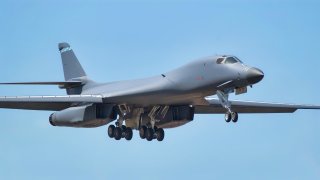The B-1B Lancer Bomber is Making the Ultimate Comeback
The U.S. Air Force is revitalizing a B-1B Lancer bomber, marking its first return from storage at the "Boneyard" in decades.
Summary: The U.S. Air Force is revitalizing a B-1B Lancer bomber, marking its first return from storage at the "Boneyard" in decades. This intricate process underscores the challenges of reactivating aircraft long stored at the 309th Aerospace Maintenance and Regeneration Group at Davis-Monthan Air Force Base, Arizona. Preserved in a state beyond mere storage, the aircraft undergo specialized treatments to mitigate deterioration. This effort aligns with maintaining a robust fleet, as parts from another B-1B, recently decommissioned after an accident, are repurposed for this resurrection. The endeavor reflects a commitment to sustaining a formidable long-range strike capability, showcasing the Air Force's adaptability and dedication to mission readiness, even as the fleet ages and faces incidents necessitating such complex regeneration processes.
The B-1B Lancer Bomber Is a Legend for a Reason...But Old
The Rockwell B-1B Lancer is still on track to be retired in the coming decade, but in the meantime, the United States Air Force needs to keep a number operation – and for that reason, a retired B-1B that was sent to the "Boneyard" for long-term storage will be making a return to service. It is the first time in nearly decades that a Lancer will re-enter service after being retired.
However, it isn't as easy as washing off the dust, and fueling it up. The process of restoring even a single B-1B Lancer so that it can be returned to service can only be described as a complicated affair.
Retired aircraft are typically preserved at the 309th Aerospace Maintenance and Regeneration Group (AMARG) at Davis-Monthan Air Force Base (AFB), Arizona. The unit – which regularly reactivates aircraft for the U.S. military, NASA, and even partner nations – also does more than just park the retired aircraft off to the side of a runway. The aircraft aren't exactly left in a presentation state and the Boneyard would never be mistaken for an aviation museum.
Retired warbirds are maintained in various conditions, but according to Air & Space Forces magazine, it generally involves filling fluid lines with preservative oil; closing off openings to keep out animals; while the cockpit, intakes and exhausts are covered with a spray-on latex preservative to diminish the effects from sun and heat. In addition, explosive devices, such as ejection set motors are removed.
B-1B Lancer Bomber: Getting the Warbird Back in the Sky
Production of the Rockwell-made supersonic variable-sweep wing, heavy bomber entered in 1988. A total of 104 B-1s were produced, but fewer than 50 remain in service. The U.S. Air Force last retired 17 B-1s between February and September 2021, after it was determined that the cost to restore them to the "status quo" would costs tens of millions of dollars for each bomber. Instead, it was decided to retire the old BONES, but four of the aircraft were maintained "in a reclaimable condition."
That will speed up the process of getting it back in the air.
The restored bomber will allow the service to keep 44 B-1Bs fully operational, and the aircraft returning to service will actually benefit from another that was taken out of service after an April 2022 incident in which a bomber caught fire during an engine run.
That aircraft's flying days were over, but following the accident investigation, maintainers were able to strip that damaged B-1B of 49 parts valued at more than $2.7 million. In October 2023, maintenance teams from Dyess AFB, Texas, and Tinker AFB, Oklahoma, began to demilitarize the damaged B-1B Lancer at Dyess AFB and subsequently facilitated the regeneration of a B-1B that will join Dyess' fleet later this year.
The left wing and left nacelle were sent to the 436th Training Squadron crash lab, the only crash lab in Air Combat Command, to support their aircraft mishap investigation course.
The fuselage was transported to Wichita State University's National Institute for Aviation Research, which created a digital twin of the B-1. As previously reported, the endeavor will aid in predicting structural issues and serve as a baseline for any future upgrades to the bomber. A highly detailed computer model could make it easier to identify potential points of failure to help keep the remaining bombers flying.
"This is an example of our team thriving despite some initial adversity," said Col. Joshua Pope, 7th Maintenance Group commander. "The demilitarization project facilitated proactive inspections and the repair of structural components by personnel, reducing repair costs, timelines, and the impact on aircraft availability, all while upholding fleet safety."
Team Dyess is now looking forward to the new arrival to replace the B-1B that was demilitarized. That aircraft recently left the "Boneyard" at Davis-Monthan AFB and landed at Tinker AFB for heavy restoration and maintenance. After numerous inspections and upgrades – which will include parts from the demilitarized bomber – that aircraft will join the Dyess fleet later this year.
"The fact that our Air Force can call up an aircraft that has sat dormant for several years and prepare it to support our long-range strike mission, all within a year, is incredible," said Col. Seth Spanier, 7th Bomb Wing commander. "This entire effort speaks to our unwavering commitment to maintaining a combat-credible strike force."
It is also possible that the teams may have to put their skills to the test more than once. The Air Force hasn't determined if the B-1B that crashed while landing at Ellsworth AFB, South Dakota, in January, will also need replacing. However, it is also being treated as a Class A mishap, the most serious type. The maintainers may have their hands full keeping the old BONE flying.
Author Experience and Expertise: Peter Suciu
Peter Suciu is a Michigan-based writer. He has contributed to more than four dozen magazines, newspapers, and websites with over 3,200 published pieces over a twenty-year career in journalism. He regularly writes about military hardware, firearms history, cybersecurity, politics, and international affairs. Peter is also a Contributing Writer for Forbes and Clearance Jobs. You can follow him on Twitter: @PeterSuciu.
You can email the author: [email protected].
Image Credit: Shutterstock.


